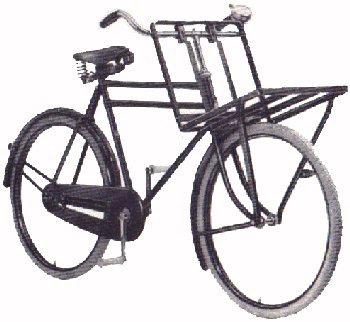| The
development of the bicycle in the late 19th century mainly took place in England, Germany,
and France. The first Dutch bicycle manufacturers copied their work. Actually, the Dutch
bicycle industry did not contribute to the initial technical design and general outfit of
the bicycle.

The developments in the above mentioned three countries were
partially different, and this difference is still apparent. For instance, in England
Sturmey Archer gear hubs with rod brakes were/are widely used, whereas Germany cycled with
Fichtel & Sachs hubs with back-pedal brakes and in France derailleur gears have long
been popular.

Old Dutch bicycles largely resemble English bicycles. Before
the turn of the century, the English bicycle industry developped more quickly than others
and therefore had the best reputation at the time. So Dutch manufacturers attempted to
make English looking bikes. Due to the flatness of the Dutch landscape, Dutch bicycles
didn't neet to be as light as bikes elseware in Europe. In fact, until the second World
War gears were quite uncommon in Holland.

Well, what is typical Dutch then?
Firstly, in Holland bicycles were widely used for transport. Only in Holland, with its
flat landscape, heavy old delivery tricycles were a feasible option. Carrier bicycles were
also used widely in Holland.

The ladies' bike with the long head tube and the bent down
tube is sometimes considered to be typical Dutch, but is actually of British origin.
Nevertheless it is a good example of another characteristic of old Dutch bicycles: the
upright cyclist's position and the comfort ride. Compared to German roadsters, Dutch
bicycles were often designed with a shorter yet higher frame. Over longer distances I have
found this riding position more comfortable, and it causes less backaches.

A second point about frame sizes is that there is probably
no other country which still has so many old bicycles riding on the streets with frames of
65 cm and above, some of which are even ladies' bikes! Furthermore, as far as I know, the
reliable Thompson bracket with 45 mm cups has only been used in Holland, and a chain case
with varnished spinnaker cover is an essential part of a real Dutch bike.

Stokvis carrier bicycle
In 1949 the trade journal "De
Nederlandsche Rijwielhandel" wrote:
|
In our country one tends to consider a
bicycle as a means of transport for virtually any purpose, and therefore people want it to
be very strong, very heavy, very solid and preferably very cheap, too. We certainly don't
want to suggest anything negative about Dutch bicycles. In fact we truly believe that they
are a fine piece of thoroughness with a strong position in international competition. |
|
- On this homepage you can find a short
overview of the Dutch bicycle industry and more detailled information about some Dutch
brands. Just click here. The given information is of course not
complete, so if you have comments or additional information please write an e-mail to cyclist@rijwiel.net.
- The second caption of this homepage is
about a database of old bicycles. This database currently contains about 3,500 Dutch
bicycles, as well as over one hundred bikes from mainly German and English origin.
With every bike, there are a number of attributes and features registered. You can add
your bicycle(s) to this database and request some information about your bikes back if
desired. Please click here.
- Another part of the homepage is the
caption about bicycle repair. Here you can find hints about how to demount rusted parts,
fix so-called broken parts and about which sizes are special for which brand. It will take
some time to write this caption, and I will probably not translate it into English anyway
(too much for me, sorry). So please take a look at the Dutch or German pages.
- For those of you who want to recall the
times when the old bicycles of today were young, or for those simply interested in
photography, this website comprises a picture gallery of pre-war,
bicycle related photos.
|